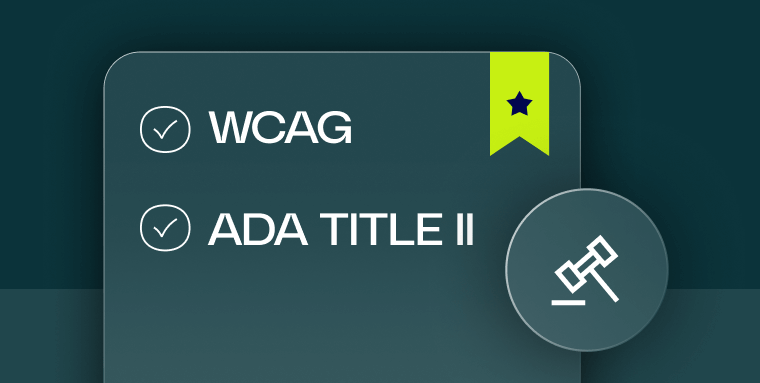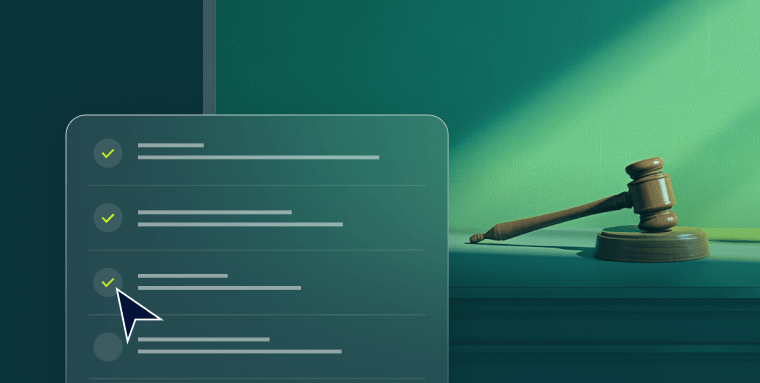Under ADA Title II, all state and local government bodies must ensure that their services, whether delivered in person or online, are accessible to people with disabilities.
This includes everything from city websites and school district portals to online payment systems, mobile apps, digital forms, and public-facing documents.
If you manage or build digital experiences for a public entity, this law applies to you.
But what does complying with the law actually entail?
In this blog, we’ll break down what ADA Title II means for your organization, and show the steps you can take to help ensure your digital content is compliant.
ADA Title II: what is and who does it apply to?
Title II of the Americans with Disabilities Act applies to all levels of state and local government. That includes departments, agencies, school districts, public universities, law enforcement, transportation authorities, and any other body that provides public services.
For a full list of bodies subject to ADA Title II, press here.
While the law was originally enacted to ensure access to public programs and spaces. such as courthouses, classrooms, and buses, it now also applies to digital services. This includes websites, mobile apps, online forms, and public-facing documents.
Under the law, public entities are required to make these services accessible to people with disabilities. That includes:
- City and town websites
- School district portals
- Public transportation apps
- Online payment systems
- Mobile apps and digital forms
It’s also worth noting that some public entities not covered by ADA Title II, such as federal agencies, may have digital accessibility obligations under Section 508 of the Rehabilitation Act.
Section 508 sets accessibility requirements for federal websites, apps, and electronic documents. While it applies only at the federal level, Title II is the governing standard for state and local governments.
How to comply with ADA Title II

To comply with ADA Title II, your website, mobile app, and other digital services will need to adhere to the Web Content Accessibility Guidelines (WCAG) 2.1 at Level AA.
WCAG has been the accepted benchmark for digital accessibility in the U.S. for several years, and is routinely referenced by U.S. courts in cases involving ADA Title III, which applies to private businesses.
What sets ADA Title II apart is that it now officially codifies WCAG 2.1 Level AA as a legal requirement. This was finalized by the Department of Justice in April 2024, and it comes with clear compliance deadlines:
- April 24, 2026 for state and local governments serving 50,000 or more people
- April 26, 2027 for smaller entities and special district governments
By their respective deadlines, covered public entities must ensure that their websites, mobile apps, and other digital assets adhere to WCAG 2.1 Level AA.
What you need to know about WCAG adherence
The Web Content Accessibility Guidelines (WCAG) are the global standard for web accessibility. Developed by the World Wide Web Consortium (W3C), WCAG provides a detailed framework for making websites and digital content usable for people with a wide range of disabilities.
At its core, WCAG is built around four key principles, often referred to by the acronym POUR:
- Perceivable: Content must be presented in ways people can recognize and process using their senses
- Operable: All interactive elements must be usable by people with different input methods
- Understandable: Website content needs to be presented in a direct, simple way
- Robust: A website’s code should be written in adherence to recognized standards, and should be compatible with assistive technology (e.g., screen readers)
Throughout the years, there have been a number of WCAG versions released: 2.0, 2.1, and 2.2, the most recent and up-to-date, published in October 2023.
Additionally, each WCAG version features three levels of conformance: Level A, Level AA, and Level AAA, with each level introducing more advanced and specific accessibility requirements.
Under ADA Title II, you are required to meet WCAG 2.1 at Level AA.
ADA Title II compliance checklist

Complying with ADA Title II in adherence to WCAG 2.1 Level AA means meeting a range of technical and content requirements that make your digital services accessible to people with disabilities.
Here are some of the most important areas to pay attention to:
- Allow for keyboard-only navigation
Ensure that all interactive elements, like menus, buttons, and forms, can be accessed via keyboard command - Ensure full compatibility with assistive technology like screen readers
Use semantic HTML and ARIA attributes so screen readers can interpret and announce content correctly
- Use highly contrasting colors
WCAG 2.1 Level AA requires a contrast ratio of at least 4.5:1 for normal-sized text and 3:1 for large text (18pt or 14pt bold). These ratios help ensure readability for users with low vision or color blindness. The same standards apply to meaningful images that include text, such as buttons, banners, and infographics.
- Provide alt text for meaningful images
Meaningful images - those that convey important information- should include alternative text. This allows screen readers to describe the image to users who can’t see it, ensuring they still receive the same content and context.
- Use proper heading structures
Organize content using a logical hierarchy of headings (H1, H2, H3, etc.) to improve screen reader navigation and content clarity
- Include captions and transcripts for videos
Add captions and transcripts to videos and audio content so users with hearing impairments can access the information.
- Design accessible forms
Use clearly labeled fields, input instructions, and error notifications that are both visible and screen reader-friendly.
- Maintain responsive and flexible design
Make sure your site functions across screen sizes and orientations, including mobile and tablet devices
- Avoid using color as the only means of conveying information
Use text labels, patterns, or icons alongside color to communicate meaning - especially in charts, buttons, and error messages
- Use descriptive URLs and link text
Avoid vague phrases like “click here.” Instead, use links that describe the destination or action
- Ensure consistent navigation
Keep menus, links, and layout elements consistent across pages to reduce cognitive load and improve usability
- Allow for content to be increased and decreased in size
Let users resize text up to 200% without loss of functionality or clarity
- Try to avoid auto-replaying media
Neutralize autoplay or provide a clear way to pause or stop audio and video content
- Ensure your website does not feature content that can induce seizures
Avoid flashing content or animations that blink more than three times per second
- Make sure your online documents are accessible
PDFs and Word documents should be tagged properly and structured for screen readers
Important note: This is only a partial list.
Setting the ground for the upcoming compliance deadlines

With the first official enforcement deadlines approaching as early as next year, now is the time for public entities to take meaningful steps toward accessibility compliance. Proactive planning helps ensure your digital services are inclusive to people with disabilities, and protects your organization from avoidable legal and reputational risks.
Properly addressing accessibility issues found in websites and online documents can be challenging. That’s why many organizations rely on comprehensive accessibility solutions, like accessiBe.
accessiBe: Get the most out of AI and human expertise
accessiBe offers a range of solutions designed to support every stage of your accessibility journey; whether you're starting with your first audit or expanding compliance efforts across your digital services.
And, in the event that you are met with legal action, we have your back with comprehensive litigation support (available in select plans).
Here’s a look at accessiBe’s ecosystem of solutions:
accessWidget
accessWidget uses AI-powered technology to help websites meet many of the core requirements of WCAG 2.1 Level AA. It enables screen reader compatibility, keyboard-only navigation, and other key features that enhance accessibility quickly and efficiently.
If you have more advanced compliance requirements, you can benefit from targeted enhancements to accessWidget, as well.
As part of a process called Manual Testing and Custom Remediation (MTCR), accessiBe’s experts audit key user flows on your site. Then, adjustments are made to accessWidget so that it optimally addresses these specific areas of your site.
accessServices
Accessibility also applies to the documents and media you publish. accessServices provides remediation for assets like PDFs and Excel sheets, to ensure they meet accessibility standards. It also offers full accessibility audits, which can include testing by individuals with disabilities to help uncover real-world usability barriers.
accessFlow
For organizations looking to embed accessibility into their development processes, accessFlow provides a comprehensive platform tailored for maximum visibility. It integrates seamlessly into existing dev workflows, allowing teams - regardless of prior experience - to identify, track, and resolve accessibility issues throughout the product lifecycle.
Take action toward compliance
The new ADA Title II requirements set a clear legal and ethical standard for digital accessibility—and the countdown to enforcement has already begun. By taking action now, public entities can identify and resolve accessibility gaps well ahead of the deadlines, minimizing legal exposure and operational disruption.
If you’d like to learn more about accessiBe and how it can help you on your journey toward ADA compliance, press here.
Frequently asked questions about ADA Title II
Q1. Who exactly is covered by ADA Title II?
A1. All state and local government entities—departments, agencies, school districts, public universities, transportation authorities, law enforcement, courts, libraries, utilities, and special districts. If you deliver public services, Title II applies.
Q2. Do public universities fall under Title II?
A2. Yes. Public K-12 and higher-ed institutions are subject to Title II. Private colleges and universities are generally covered under Title III; many still adopt WCAG AA to reduce risk and improve access.
Q3. What are the compliance deadlines again?
A3. Entities serving 50,000+ people: April 24, 2026. Smaller entities and special districts: April 26, 2027.
Q4. What standard do we have to meet?
A4. WCAG 2.1 Level AA for websites and mobile apps. That includes requirements around keyboard access, color contrast, alternative text, captions/transcripts, clear headings, accessible forms, and properly tagged documents.
Q5. Does Title II cover mobile apps and PDFs?
A5. Yes. Mobile apps and most public-facing digital documents (like PDFs, Word files, and slide decks) must be accessible. Plan for document remediation and app testing in your roadmap.
Q6. Are there any exceptions or “safe harbors”?
A6. There are limited nuances (e.g., some archived content), but most current public content and services must meet WCAG 2.1 AA.
Q7. Are entities responsible for accessibility when using third-party vendors or platforms?
A7. You’re responsible for the accessibility of services you procure or embed. Bake accessibility into contracts and RFPs, request VPATs/ACRs, and test real user flows before go-live.
Q8. How should entities prioritize accessibility efforts with limited resources?
A8. Start with high-traffic, high-impact tasks (payments, applications, service requests, student portals). Use automated scanning to find patterns, then apply expert review to critical flows. Publish an accessibility statement to provide help while you remediate.
Q9. What level of enforcement currently applies under ADA Title II?
A9. Title II is enforceable today. While the DOJ has indicated it will review aspects of existing ADA regulations, there’s no timeline—and no pause on compliance. Staying focused on WCAG 2.1 AA and critical user journeys is the right path.
Q10. How does ADA Title II relate to Section 508 requirements?
A10. Section 508 applies to federal agencies and sets its own technical standards. State and local entities follow Title II—but 508-style procurement practices (like requiring VPATs) are great for raising the bar with vendors.





